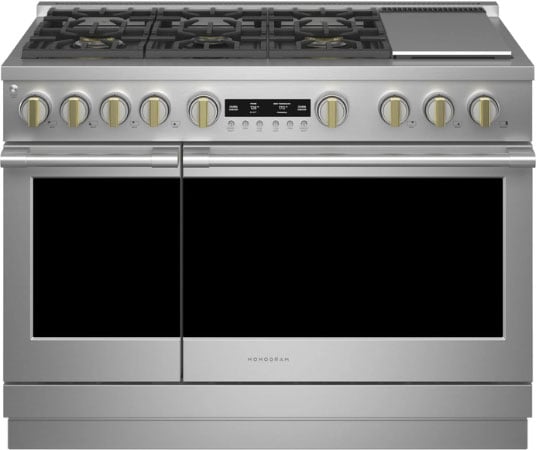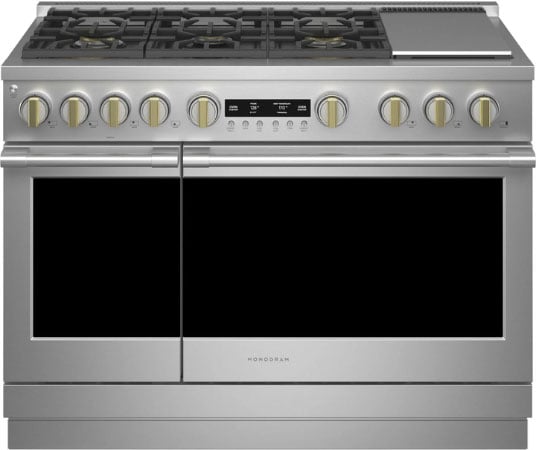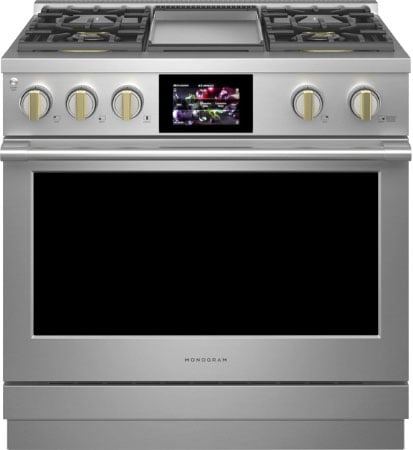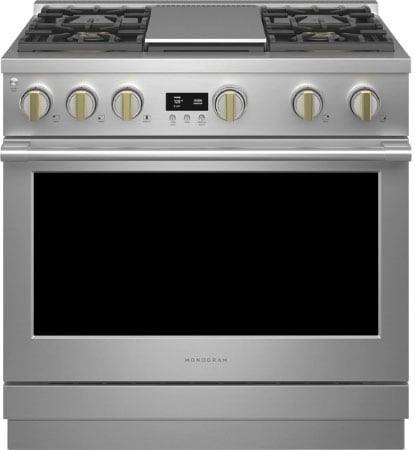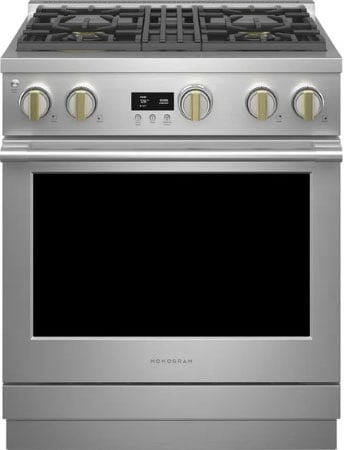What's the Difference Between All Gas and Dual Fuel Professional Ranges?
April 2nd, 2024 | 6 min. read

In this article, you will learn the differences between all gas and dual fuel ranges, from how they perform to each fuel type's special features.
This article will focus on professional ranges because of their popularity in dual fuel.
If you are looking for a 30-inch dual fuel or all-gas range like Café Appliances or LG, the same basic rules and considerations apply.
Well, almost the same.
However, there's a slight twist with professional ranges, as they offer additional features not directly related to the fuel type.
It's also common for people to be pushed into buying a dual fuel range when they step into an appliance store.
But, depending on how you cook, this could be a big mistake.
This article will help you choose a range based on your cooking style.
Let's get started.
My Mother Buys a Dual Fuel Range

My mother used to broil everything when I was a kid.
You name it, she could and would broil it.
When she wasn't broiling, she was roasting.
Her pot roast was legendary, and it's the reason I wouldn't touch meat for over thirty years.
Mom's cooking aside, I thought it was curious when she bought the Wolf dual fuel 30-inch range, for reasons you will understand after reading this article.
What Is the Difference Between All Gas and Dual Fuel Ranges?
.jpg?width=799&name=yale-appliance-36-inch-pro-gas-range%20(1).jpg)
An all-gas range has a gas stovetop with a gas oven, while a dual-fuel range has the same gas stovetop but with an electric oven.
Many believe that a dual fuel range is automatically better than a gas range, mostly because dual fuel is sold that way in your appliance stores.
That is not entirely true.
It may be a bad decision based on your cooking preferences, like Mom's.
There are important differences between all gas and dual fuel ranges.
All gas and dual fuel ranges differ in their oven's performance, installation, and price. For pro ranges, you have added features on dual fuel ranges to consider as well.
Cooking Performance
Roasting
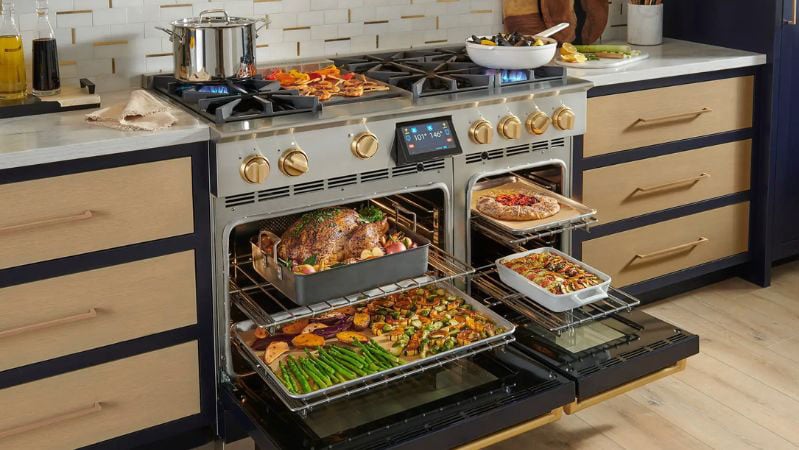
A gas range's oven uses a moist heat that is better for roasting
Roasting needs moist heat with higher temperatures.
Roasting in a gas oven is great for more structured foods like proteins and vegetables while giving them a richer color.
Electric ovens are a drier heat and not as good an option for roasting
Baking

A dual fuel range uses drier heat that is more evenly distributed throughout the oven from convection fans.
Pure, European, and True convection are interchangeable terms referring to convection heat being blown from the back.
That drier, more precise heat is better for baking.
Gas ovens typically use radiant heat from the bottom of the oven.
It's not blown in from the back of the oven like in a convection oven.
Only BlueStar, Signature Kitchen Suite (SKS), and Hestan offer a pure convection gas range.
More even heat distribution is a huge advantage and is far better than having heat circulate from the bottom and then blown around by a fan.
Broiling Between All Gas and Dual Fuel
Broiling is far better in a gas oven rather than an electric oven.
A few years ago, our resident chef compared Wolf's dual fuel range and electric broiler with BlueStar's gas range and infrared broiler.
As you can see below, the infrared broiler from BlueStar was significantly faster.

You have a gas grill, not an electric one, outside your home because gas heats up instantly, whereas electric grills take time to warm up.
Most pro gas ranges have hotter infrared broilers, unlike a regular dual fuel range.

An infrared broiler uses direct heat, which is great for searing your food compared to diffusing the heat like a regular gas burner.
The sear burner on a Lynx or any other high-end grill is, in fact, an infrared grill.
The hottest infrared broiler is Miele's at 23,000 BTU, followed by Wolf's, JennAir's, Thermador's, and BlueStar's broilers.
Installation
For a dual fuel range, you'll need a gas line and an electrical supply of 30-50 amps for the electric oven.
This requirement varies depending on the size of your oven: whether it's a single 30 or 36-inch oven or a double oven at 48 or 60 inches.
With an all-gas range, you are installing the gas line with a simple 120-volt, 12-amp line.
The receptacle is like what you already have in your home to plug other household appliances.
You will need an electrician to rewire from gas to dual fuel.
You can't just plug in a 240-volt appliance into a 120-volt outlet.
Price Differences Between Dual Fuel and All Gas Pro Ranges
Dual fuel ranges are more expensive than gas by 10%-20%.
For instance, a Monogram's 48-inch dual fuel range is roughly $14,000, while the all-gas version is $11,000.
In 36 inches, the difference is $11,400 for the dual fuel versus $7,800 for the all gas.
In 30 inches, the price is $6,800 for the dual fuel versus $5,600 for all gas.
Feature Differences Between Dual Fuel and All Gas Pro Ranges
A dual-fuel pro range offers more features depending on the brand and size, unlike a regular standard range like a GE or LG.
Your dual-fuel range could have feature upgrades like self-cleaning, steam, better controls, a clock, and a timer, depending on the brand.
Gas ranges are less expensive, but you will have fewer features depending on the brand.
Thermador All Gas vs. Dual Fuel Ranges
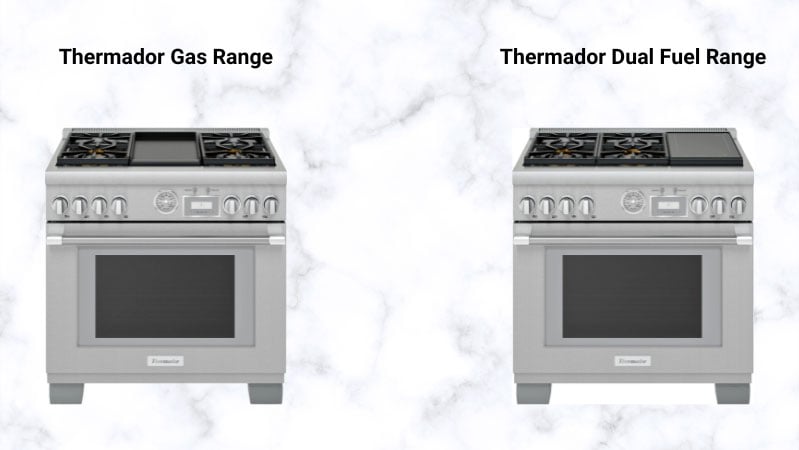
Thermador has two series, the Pro Grand and the Pro Harmony
Thermador offers self-cleaning in its dual fuel ranges and a few extra cooking modes.
In their 48-inch and 60-inch sizes in their Pro Grand series, they offer induction burners as an option, plus steam and warming drawers.
Wolf All Gas vs. Dual Fuel Ranges

Wolf is completely different between dual fuel and all gas ranges.
Wolf's dual fuel ranges offer a higher burner output, a clock, timer, self-cleaning, and twin convection, unlike their gas range.
It is Wi-Fi enabled and offers their Wolf Gourmet guided cooking system.
You input the food and how you want it cooked. The Gourmet system will calculate time, temperature, and even rack position.
Wolf's gas range offers only 15,000 BTUs on their burners, while their dual fuel has a combination of 20,000, 18,000, and 15,000 BTUs.
Reflecting on my mom's choice, she might have been better off with an all-gas range. However, the Wolf dual fuel range is, admittedly, a better range.
Miele All Gas vs. Dual Fuel Ranges
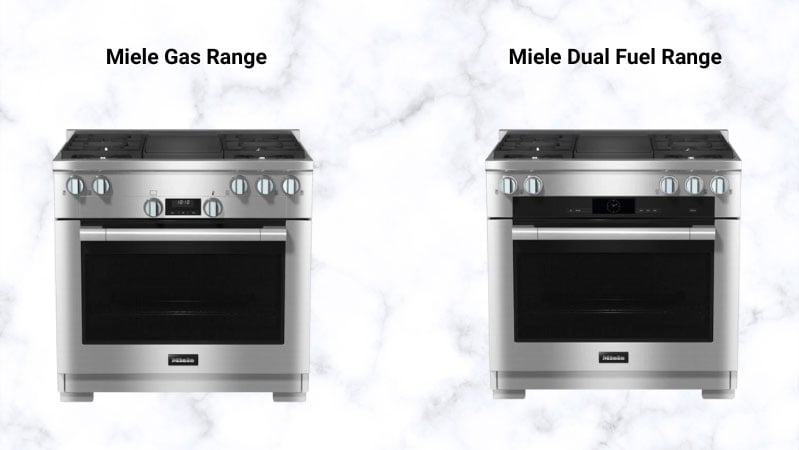
Miele does not add extra burner output on the stovetop like Wolf, but they introduce steam assist in all their dual fuel ranges and smart technology.
You can add steam to a cycle or automatically bake bread in the Miele oven.
Additionally, Miele was the first to add sophisticated controls to their professional range.
Their MasterChef control system is completely intuitive. All you have to do is choose the food type and press a button.
The oven calculates time and temperature automatically. It will also provide step-by-step instructions for cooking your food.
In 48-inches, Miele only has dual fuel.
Monogram All Gas vs. Dual Fuel Ranges
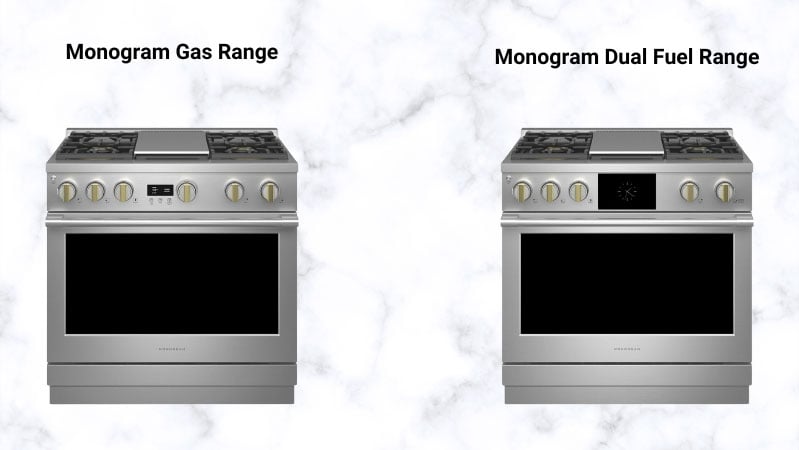
Monogram offers two types of dual fuel ranges, with the clock being the main difference.
You can choose their articulating 7-inch clock as an option.
Self-cleaning on dual fuel is the main difference between all-gas and dual fuel, plus a few cooking modes.
BlueStar All Gas vs. Dual Fuel Ranges
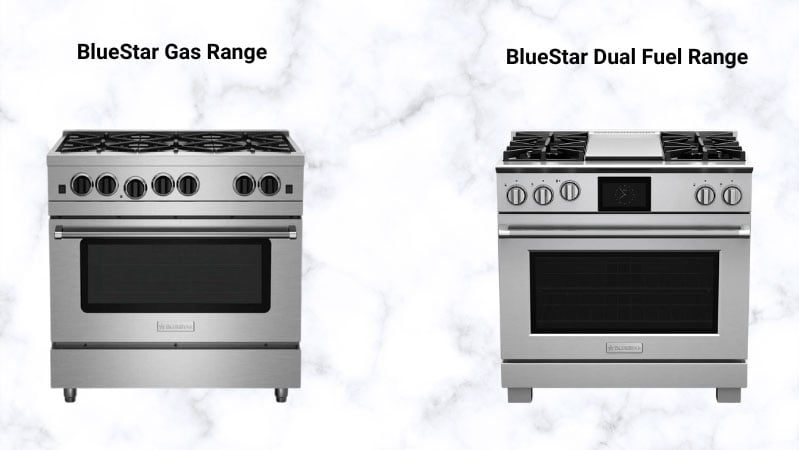
After years of touting the power of the open burner, BlueStar's dual fuel range now offers a sealed yet still hot 25,000 BTU burner.
The "X8" burner offers more diameter to keep an even heat throughout the pan (or so they say).
BlueStar also offers their seven-inch clock only on their dual-fuel ranges.
SKS All Gas vs. Dual Fuel Ranges
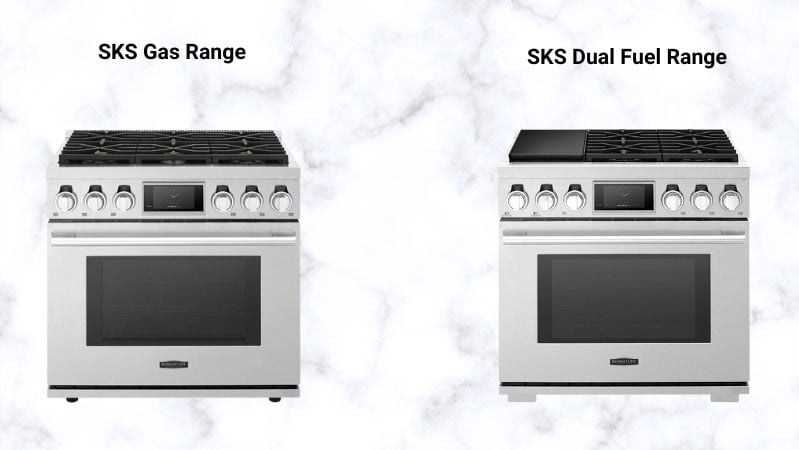
SKS offers a combi steam oven in their 48-inch dual fuel ovens along with a sous vide stovetop option vs. just the oven and griddle option in all gas.
Should You Buy an All Gas or Dual Fuel Range?
It depends on how you like to cook in your oven.
Both have advantages and disadvantages.
If you like to roast meats, a gas convection system is better because it is more moist than electric.
Broiling is far better with a gas infrared broiler than with an electric one, especially in a pro range.
Gas is less expensive to buy and easier to install than electric in most cases. It does not require the same electrical load as gas.
Moreover, if you have limited electrical outlets, then gas is a better option.
With dual fuel, you will have more advanced features than a gas range, like steam ovens or steam assist, intuitive controls, and self-cleaning, depending on the manufacturer.
Also, your dry electric oven will produce better results for baking versus moist gas heat.
In Summary:
- If you cook more meats and poultry or use the broiler often, an all-gas range would be the way to go.
- If your cooking style is geared toward more baking, a dual-fuel range is your best option.
- If you do an equal amount of baking and roasting and want to save a little money, choose an all-gas range.
- With pro ranges only consider functionality differences.
Additional Resources
Craft the kitchen of your dreams. Access the ultimate pro range buying guide now. Trusted and read by over 1 million homeowners- your gourmet journey begins here."
Transform your kitchen with insights on the finest ranges available. Over 1 million readers can't be wrong. Download the free Pro Cooking Buying Guide now.
Related Articles
- Most Reliable Professional Ranges
- Best 36-Inch Dual Fuel Professional Ranges
- Best 36-Inch Professional Gas Ranges
- Best 48-Inch Pro Ranges
- Are Wolf Pro Ranges Worth It?
- How to Buy a Professional Range
Recent Posts
Why Should You Trust Us?
It seems that every appliance review has nothing but glowing comments about almost every product, yet you read customer reviews and they are almost universally bad.
We are here to fill in the disconnect. We'll give you the best features, and the drawbacks as well, including reliability based on over 37,000 calls performed by our service team just last year. Our goal is to give you ALL the information so you know what's right for you.
Please consider subscribing or adding to the conversation in the comments below. We appreciate you stopping by.
Steve Sheinkopf is the third-generation CEO of Yale Appliance and a lifelong Bostonian. He has over 38 years of experience in the appliance industry, and he is a trusted source of information for consumers on how to buy and repair appliances.
Steve has also been featured in numerous publications, including the
New York Times,
Consumer Reports,
The Boston Globe,
Bloomberg Radio, the
New York Post,
The Wall Street Journal, and
Entrepreneur, for his knowledge of how to buy appliances and appliance repair.
Steve is passionate about helping consumers find the best appliances for their needs, and he is always happy to answer questions and provide advice. He is a valuable resource for consumers who are looking for information on appliance buying, repair, and maintenance.
Despite being the worst goalie in history, Steve is a fan of the Bruins and college hockey, loves to read, and is a Peloton biker. The love of his life is his daughter, Sophie.
A Note About Pricing
Pricing on this blog is for reference only and may include time sensitive rebates. We make every attempt to provide accurate pricing at time of publishing. Please call the stores for most accurate price.


